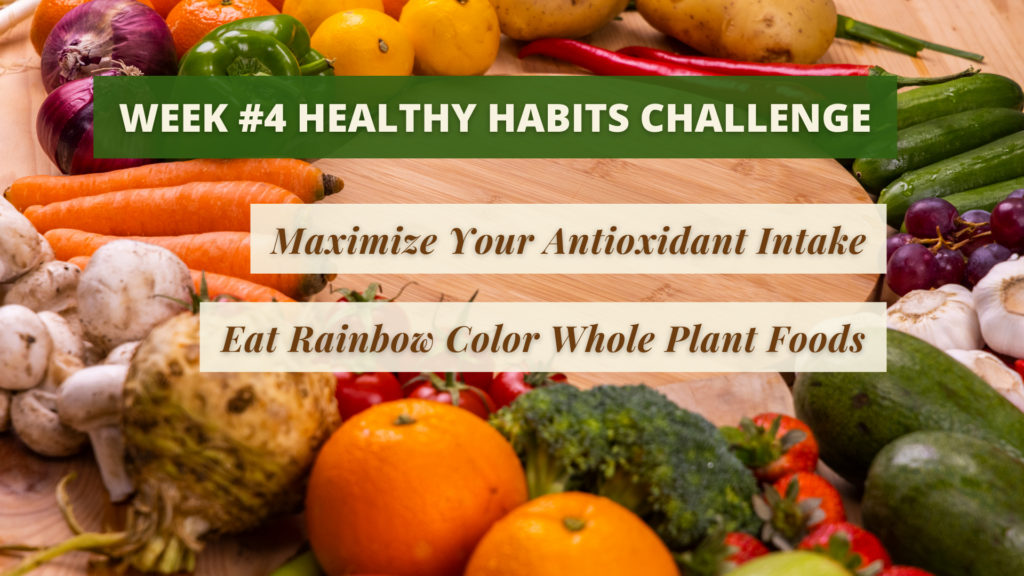Join our mailing list to receive the latest health tips and updates.
You have Successfully Subscribed!
Week #4 Healthy Habits Challenge – Maximize Your Antioxidant Intake, Eat Rainbow Color Whole Plant Foods

Welcome to Week #4 of the 12-Week Healthy Habits Challenge!
Let’s continue cultivating EAT TO LIVE healthy habits this week.
Last week, we discussed the importance of eating a whole food diet, especially a diet rich in whole plant foods, which is naturally anti-inflammatory.
Note that chronic inflammation and the associated oxidative stress (excess free radicals causing damage to cells, tissues, DNA) have been found by numerous scientific studies to be the major culprits of many chronic diseases/disorders that have become so prevalent in our modern society.
These chronic diseases/disorders include obesity, type-2 diabetes, hypertension, heart disease, cancer, Alzheimer’s disease/dementia, mental disorders, chronic liver disease, chronic kidney disease, osteoporosis, etc.
There is also a strong association between chronic inflammation and aging and age-related chronic diseases, wherein the term ‘inflamm-aging’ has been coined.
Many factors can contribute to chronic inflammation including diet and lifestyle factors, as well as exposure to environmental toxins.
In the case of diet, a diet rich in antioxidants and anti-inflammatory compounds is desirable to help to combat oxidative stress and chronic inflammation, and reducing the risk of chronic diseases.
As shown by numerous scientific studies, such a diet typically consists of plenty and a large variety of whole fruits and vegetables, moderate amount of legumes and whole grains, and low-to-moderate amount of healthy fats from nuts, seeds, avocado, olive, etc.
(For more details and the relevant scientific studies, please check out my previous articles:
While eating a whole food plant-rich diet, it is also important to eat from a wide variety of rainbow color whole plants foods, as further discussed below.
Why Eat a Wide Variety of Rainbow Color Whole Plant Foods?
Whole plant foods contain tens of thousands (many have yet to be discovered) of phytonutrients (plant nutrients) that exert various health promoting and disease preventing properties, including antioxidants, anti-inflammatory, anti-cancer, anti-microbial, anti-aging, immune modulation, liver protective, cholesterol lowering, etc.3
Different types of whole plant foods constitute different compositions of bioactive phytonutrients and antioxidants, exerting a wide range of health promoting effects.
Different plant pigments (in fruits, vegetables, legumes, whole grains, nuts, and seeds) typically correspond to different phytonutrients or phytonutrient categories. Some examples are listed here (note: this is just a very short list shown as examples): red->lycopene and astaxanthin, orange->beta-carotene, yellow->hutein/zeaxanthin, green->chlorophyll and folate, purple->flavonoids and anthocyanins, etc.1,2
Research has shown some general health benefits trend associated with different plant pigments, as summarized below:1
- Red foods: Anti-inflammatory, antioxidant, immune modulation.
- Orange foods: Antioxidant, hormone regulation and fertility support.
- Yellow foods: Antioxidant, gut and digestive health, blood sugar regulation.
- Green foods: Antioxidant, cardiovascular health.
- Blue-purple foods: Antioxidant, brain health, mental health.
Therefore, to maximize the health benefits, it is important to consume a wide variety (for “nutrient diversity”) and rainbow color (for “antioxidant diversity”) of whole plant foods.
Among various plant foods, those that are high in antioxidant content/density (not necessary variety) are herbs and spices, berries, nuts and seeds.2
Tips to Incorporate Rainbow Color Whole Plant Foods into the Diet
Here are some tips to incorporate a wide variety of rainbow color whole plant foods into your diet:1
- Target to incorporate whole plant foods of all the major color pigments (i.e., red, orange, yellow, green, blue-purple) into your diet within a week. Consume a wide variety of whole plant foods associated with each color pigment. Some examples are listed below. (Note that most whole plant foods, including those listed below, usually contain more than one color pigment.)
- Shop at local farmers’ markets where you may find a wider variety of fruits and vegetables which may not be commonly found in grocery stores.
- Red: Red apples, pomegranate, red cabbage, radicchio, red beets, red bell peppers, red kidney beans, adzuki beans, red rice, etc.
- Orange: Apricots, peaches, mangoes, papaya, carrot, pumpkin sweet potatoes, red lentils, walnuts, pecans, etc.
- Yellow: Bananas, Asian pears, lemons, pineapples, ginger, corn, potatoes, squash, yellow peas, millet, amaranth, quinoa, flaxseed, almonds, etc.
- Green: Pears, avocado, leafy green vegetables, broccoli, cabbage, green beans and peas, zucchini, herbs, green lentils, mung beans, pistachios, sunflower seeds, etc.
- Blue-purple: Blackberries, blueberries, figs, prunes, eggplant, purple cabbage, purple kale, purple cauliflower, black beans, black/forbidden rice, etc.
Join me for this Week #4 Healthy Habits Challenge!
Perhaps be adventurous and have fun trying out various colorful whole fruits, vegetables, legumes, whole grains, nuts and seeds that you haven’t eaten before. 😊
Related Articles
Why Adopt an Anti-inflammatory Diet & Lifestyle and How?
References
- Minich DM. A Review of the Science of Colorful, Plant-Based Food and Practical Strategies for “Eating the Rainbow” [published correction appears in J Nutr Metab. 2020 Nov 28;2020:5631762]. J Nutr Metab. 2019;2019:2125070. Published 2019 Jun 2. doi:10.1155/2019/2125070
- Carlsen MH, Halvorsen BL, Holte K, et al. The total antioxidant content of more than 3100 foods, beverages, spices, herbs and supplements used worldwide. Nutr J. 2010;9:3. Published 2010 Jan 22. doi:10.1186/1475-2891-9-3
- Gupta C, Prakash D. Phytonutrients as therapeutic agents. J Complement Integr Med. 2014;11(3):151-169. doi:10.1515/jcim-2013-0021
